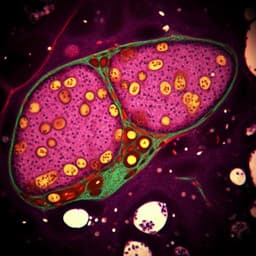
Medicine and Health
The developmental timing of spinal touch processing alterations predicts behavioral changes in genetic mouse models of autism spectrum disorders
A. Tasnim, I. Alkislar, et al.
Discover groundbreaking insights into how altered somatosensory reactivity in autism spectrum disorders (ASDs) can shape behavior. This research by Aniqa Tasnim, Ilayda Alkislar, Richard Hakim, Josef Turecek, Amira Abdelaziz, Lauren L. Orefice, and David D. Ginty reveals that timing of sensory disruptions predicts adult behaviors, offering fresh perspectives on ASD phenotypic diversity.
~3 min • Beginner • English
Introduction
Sensory processing dysfunction, including atypical tactile reactivity, is highly prevalent in ASD and often precedes diagnosis. Early-life touch experiences shape cognitive and social development, and early alterations in tactile processing can predict later ASD-associated traits. However, ASD is heterogeneous, complicating early diagnosis and prognostication. The study aims to define how the locus (peripheral vs spinal) and developmental timing (embryonic/neonatal vs later postnatal) of neural circuit disruptions in mouse models of ASD relate to tactile reactivity and to adult anxiety-like and social behaviors. The authors hypothesize that models with early tactile overreactivity will show adult anxiety-like and social deficits, whereas models with late-emerging tactile overreactivity will not, and that distinct synaptic mechanisms (presynaptic inhibition in peripheral afferents versus spinal feedforward inhibition) underlie these trajectories.
Literature Review
Prior work shows that multiple ASD-linked genes (Mecp2, Gabrb3, Shank3, Fmr1) yield tactile overreactivity in rodents. Peripheral mechanosensory neuron expression of Mecp2, Gabrb3, and Shank3 is required for normal adult tactile behavior; developmental (but not late postnatal) deletion in these neurons drives adult tactile overreactivity plus anxiety-like and social deficits, indicating a critical postnatal period during which intact somatosensory activity protects against later behavioral abnormalities. Neuroligin family members (Nlgn2, Nlgn4) organize inhibitory synapses; Nlgn2 contributes to GABAergic and glycinergic synaptic function in CNS regions. Spinal Rorb-expressing interneurons mediate feedforward inhibition and are required for normal touch and sensorimotor function. These data suggest separate peripheral presynaptic and spinal feedforward inhibitory mechanisms can shape tactile processing across development.
Methodology
Mouse models: Global and conditional mutants for ASD-associated genes were studied: Gabrb3+/− or −/−, Mecp2+/− (female) or −/y (male), Nlgn2+/− or −/−, Rorbhl/+ or −/−, and Nlgn4−/−. Conditional deletions targeted peripheral sensory neurons (AvilCre), spinal cord caudal to C2 (Cdx2Cre), and dorsal horn LTMR-recipient neurons (Lbx1Cre). Lines for optogenetics used intersectional ReaChR expression with Avil and LTMR subtype-specific CreER drivers (RetcreER, TrkBcreER, TrkCcreER) to activate Aβ-LTMR subclasses in forepaw, hindpaw, and back hairy skin at P0 and E18.5.
Behavioral assays: Adult tactile prepulse inhibition (PPI) of acoustic startle with 0.9 psi air puff prepulse; response to air puff alone; open field (time in center, distance traveled); three-chamber social interaction; elevated plus maze; texture and shape/color novel object recognition tests. Neonatal tactile sensitivity assay at P4: sequential air puffs (0.10–1.0 psi, 50 ms) aimed 2–3 mm above nape; movement quantified via optical flow (peak displacement within 500 ms). Ten repetitions of 1.0 psi tested average responsivity and habituation (≥25% decrease between first and last three trials classified as habituation). Topical lidocaine and hair removal controls validated somatosensory dependence.
Embryonic/neonatal optogenetic assay: Single 50 ms, 470 nm light pulses (five trials, 20–30 s intervals) delivered to paws or back skin of E18.5 and P0 pups expressing ReaChR in defined LTMRs; displacement quantified as above.
Electrophysiology: DRG whole-cell current-clamp recordings at P4 and P18–P30 with RuBi-GABA uncaging (5 ms light pulses) targeted to medium/large-diameter neurons; tested GABA-evoked depolarizations and dependence on Gabrb3. Spinal cord slice whole-cell voltage-clamp recordings in sagittal slices from laminae III–IV interneurons and PSDCs: measured mIPSCs (with NBQX, CPP, TTX; gabazine or strychnine to parse GABA vs glycine) at P4 and P19–P21; mEPSCs assessed with inhibitory blockers present. Retrograde labeling of PSDCs via CTB injections to dorsal column or nuclei enabled targeted recordings.
Immunohistochemistry and in situ hybridization: Assessed expression/localization of GABRB3, NLGN2, gephyrin, glycine receptor α1, VGLUT1, VGAT in neonatal and adult dorsal horn; DRG expression of MECP2 and Nlgn2 transcripts (RNAscope); quantified proximity/colocalization of synaptic markers across development and genotypes.
Statistics: Normality and variance tested; appropriate parametric/non-parametric tests applied (t-tests, Welch’s t, Mann–Whitney U, ANOVA/Kruskal–Wallis with post hoc tests, mixed-effects for repeated measures, Fisher’s exact for habituation proportions). Investigators were blinded to genotype for behavioral/electrophysiology analyses; both sexes used unless specified.
Key Findings
- Adult tactile overreactivity is present across models: Gabrb3, Mecp2, Nlgn2, and Rorb mutants showed increased tactile PPI (for example, PPI: Gabrb3−/− vs +/− P=0.0071; Mecp2−/y vs +/− P=0.0033; Nlgn2−/− vs +/− P=0.0043; Rorb−/− vs +/− P=0.0015). Responses to air puff alone were elevated for Gabrb3, Mecp2, Nlgn2, but not Rorb (e.g., P=0.0003 for Mecp2, P=0.7374 for Rorb).
- Comorbid adult behaviors differ by model: Gabrb3 and Mecp2 mutants showed increased anxiety-like behavior (reduced open-field center time; e.g., Gabrb3−/− vs +/+ P<0.0001; Mecp2−/y vs +/− P=0.0022) and reduced sociability (three-chamber preference P<0.05). Nlgn2 and Rorb mutants exhibited normal anxiety-like and social behaviors.
- Developmental timing of tactile overreactivity diverges: At P4, Gabrb3−/− and Mecp2−/y pups showed heightened displacement to air puffs across intensities and reduced habituation to repeated 1.0 psi stimuli (Gabrb3 P=0.0244; Mecp2 P=0.0317). Nlgn2−/− and Rorb−/− P4 pups were indistinguishable from controls in responsivity and habituation.
- Embryonic onset: Optogenetic activation of Ret+ Aβ-LTMRs evoked measurable movements at P0 and E18.5. Gabrb3−/− embryos/pups were overreactive to forepaw Ret+ Aβ-LTMR stimulation at P0 (P=0.0169) and E18.5 (P=0.0029), indicating embryonic emergence of overreactivity when presynaptic inhibition is disrupted.
- Locus-specific mechanisms: Peripheral sensory neuron deletion of Gabrb3 (AvilCre;Gabrb3fl/fl) recapitulated adult tactile overreactivity to PPI and air puff and induced anxiety-like and social deficits; dorsal horn neuron deletion (Lbx1Cre;Gabrb3fl/fl) did not affect tactile sensitivity or affective/social behaviors. In contrast, spinal cord deletion of Nlgn2 (Cdx2Cre;Nlgn2fl/fl or Lbx1Cre;Nlgn2fl/fl) reproduced adult tactile overreactivity and texture discrimination deficits without anxiety/social changes; sensory neuron deletion (AvilCre;Nlgn2fl/fl) had no tactile phenotype.
- Developmental emergence mirrors locus: At P4, AvilCre;Gabrb3fl/fl pups were overreactive and showed reduced habituation (mixed-effects genotype effect F1,36=36.38, P<0.0001; habituation Fisher’s exact P=0.0171), whereas Cdx2Cre;Nlgn2fl/fl pups were normal (F1,36=0.1169, P=0.7344).
- Mechanistic physiology: DRG medium/large neurons at P4 and P18–P30 exhibited robust GABA-evoked depolarizations that were abolished by sensory neuron Gabrb3 deletion, confirming early functional presynaptic GABAA receptors on primary afferents. In the dorsal horn LTMR-recipient zone, mIPSCs were sparse and small at P4 and became frequent and larger by P19–P21; early inhibition was predominantly GABAergic (gabazine-sensitive), whereas mature feedforward inhibition was largely glycinergic (strychnine-sensitive). Nlgn2 was required for mature (P19–P21) inhibitory transmission (mIPSC frequency and amplitude reduced in Cdx2Cre;Nlgn2fl/fl, P=0.0003 and P=0.0001) but dispensable at P4; mEPSCs were unaffected.
- Synaptic anatomy: GABRB3 puncta apposed to VGLUT1+ sensory terminals are present by birth, supporting early presynaptic inhibition. NLGN2 and gephyrin puncta at VGAT terminals were low/undetectable at P4 and robust in adults, paralleling late maturation of feedforward inhibition.
- Behavioral linkage: Early-life tactile overreactivity (presynaptic inhibition defects: Gabrb3, Mecp2) predicts adult anxiety-like behavior increases and social deficits, whereas late-emerging tactile overreactivity (feedforward inhibition defects: Nlgn2, Rorb) does not.
Discussion
The study demonstrates two distinct pathways to tactile overreactivity with divergent developmental trajectories and behavioral consequences. Disruption of presynaptic GABAergic inhibition of low-threshold mechanoreceptor afferents (via Gabrb3 or Mecp2 loss) manifests embryonically/neonatally, causing early tactile overreactivity and reduced habituation, and is associated with adult anxiety-like and social behavior abnormalities. Conversely, disruption of spinal feedforward inhibition (via Nlgn2 loss in dorsal horn neurons or mutations affecting Rorb-expressing inhibitory interneurons) matures later, yields adult tactile overreactivity without early-life abnormalities, and does not produce anxiety/social deficits. Electrophysiology and immunohistochemistry support this timing: presynaptic machinery is in place by birth, while dorsal horn feedforward inhibition strengthens over the second postnatal week and becomes largely glycinergic and Nlgn2-dependent. These findings link the developmental timing and locus of sensory circuit dysfunction to the heterogeneity of ASD-related phenotypes and suggest that early sensory dysfunction may contribute causally to later affective and social alterations. The work supports the concept of chronogeneity in ASD by positing variable onset of spinal sensory circuit alterations, potentially informing stratification, prognosis, and timing of interventions targeting sensory processing.
Conclusion
This paper identifies the developmental timing and circuit locus of tactile processing alterations as predictors of adult behavioral outcomes in ASD mouse models. Early-onset tactile overreactivity driven by loss of presynaptic inhibition in peripheral mechanoreceptors (Gabrb3, Mecp2) predicts later anxiety-like increases and sociability deficits, whereas late-onset overreactivity from impaired dorsal horn feedforward inhibition (Nlgn2, Rorb) does not. Mechanistically, presynaptic GABAA receptor-mediated inhibition is functional by birth, while dorsal horn feedforward inhibition matures later and requires Nlgn2 for robust glycinergic transmission. These insights clarify divergent mechanisms underlying sensory symptoms in ASD models and suggest that identifying and mitigating early tactile overreactivity could reduce later comorbidities. Future work should determine the precise temporal alignment between emergence of spinal feedforward inhibition and behavioral changes, assess touch-evoked circuit dynamics across development in these mutants, and test targeted, temporally specific interventions to normalize early sensory activity and potentially improve higher-order outcomes.
Limitations
The study is preclinical and conducted in mouse models, which may limit direct generalizability to humans. The behavioral assays focus on selected anxiety-like and social measures; other ASD-relevant domains were not assessed. For Nlgn2 and Rorb models, the exact timing at which tactile overreactivity emerges relative to maturation of feedforward inhibition remains to be precisely mapped. Synaptic colocalization analyses rely on confocal proximity measures that may overestimate true synaptic apposition due to optical limits. It remains to be determined whether and how touch-evoked spiking and network dynamics in dorsal horn circuits are altered across development in these models.
Related Publications
Explore these studies to deepen your understanding of the subject.







